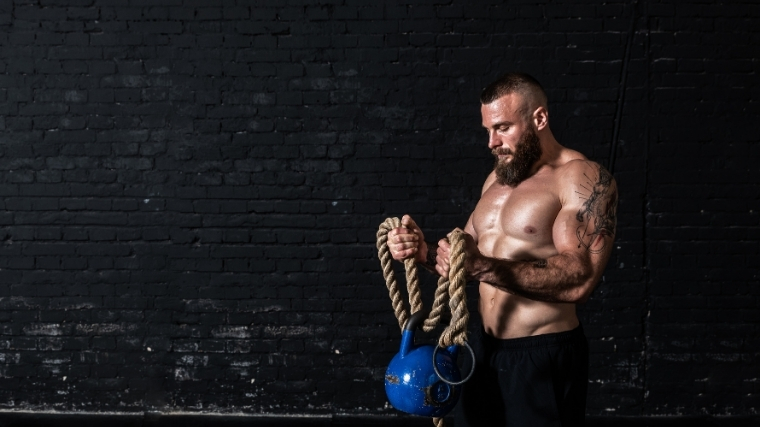Bodybuilders need to lift lots of weights to become muscular and, as a result, need to be strong to lift all those weights. You don’t really see many weaklings standing on the Olympia stage after all, do you?
That said, the strength training these men and women undergo looks a lot different than that of powerlifters. With very few exceptions — we’re looking at you, Ronnie Coleman — you don’t really see many bodybuilders squatting or deadlifting 800 pounds. That’s not to say bodybuilders are weak. They’re not. They just don’t need maximal strength to excel in their sport.
In this article, we’ll take a look at how bodybuilders train for strength while also keeping an emphasis on their muscle shape and conditioning.
What is Strength Training?
In bodybuilding, there are two important training categories: strength and hypertrophy training. The first one is the one we’re here to talk about — the process of getting stronger. The latter refers to the process of making your muscles bigger.

[Related: How to Gain Muscle — a Guide to Eating for Mass]
In theory, the two are very similar. You’re stressing the body through some form of resistance exercise (be that bodyweight training, weightlifting, CrossFit, etc.), but in practice, they’re worlds apart.
One of the biggest differences is that strength training requires heavier weights but with less volume lifted. More simply put: you’ll be doing a higher percentage of your one-rep max but for fewer reps and with a longer rest period in between sets (more on all this later). This philosophy goes for your main lifts (bench press, deadlifts, and squats) as well as your accessory lifts. (1)
Although different in practice, strength, and hypertrophy training work hand-in-hand. Studies have shown that strength training helps preserve lean muscle mass in adults and improve overall health markers, cut body fat, and even decrease cholesterol levels. There’s even proof that it can help your mental health as well. (2)
It’s All in Your Brain
Here’s something that many can’t seem to wrap their minds around — people with smaller biceps might be able to lift more than those with 24-inch pythons. How could this be?
At the end of the day, strength training actually has more to do with your brain than with your muscles. Here’s a quick breakdown: Everything you do starts with your brain, which sends messages (or signals) via the central nervous system to your muscles to complete an action.
Let’s take a deadlift, for example. Your brain tells your feet to get into position, instructs your hips to hinge, and notifies your hands to grasp the barbell before demanding your arms to pick it up while reminding your feet to stay grounded.
In a way, strength training is a bit like improving your memory. Just as you’d repeat lines for a play until you can recite them without notes, you have to replicate certain movements until your brain can instruct applicable muscles to do them as if they were second nature.
The more often you do it, the easier it becomes. Then, the same way you’d begin memorizing your next scene after committing the first to memory, you’ll add more weights until your body can handle that load without issue, and so on.
While strength training obviously impacts your muscles and health, multiple studies have concluded that your brain is the first to benefit from it. One recent study found strength training can even create new neurons in the brain’s memory center, which, in turn, help reverse age-related memory loss. (3)(4)
Programming Strength Training
As we mentioned before, there are some big differences in how to go about training for strength than training for muscle growth. We’ll dive into that a little bit further here.
Sets, Reps, and Rest Periods
Your body is an adaptable machine, almost like a T-8000 Terminator (almost). You can throw a lot at it, and it will find ways to recover and overcome those challenges. Your central nervous system, though, is more like a laptop. It can only handle so much before it overheats or needs to be recharged.

[Related: How Bodybuilding is Judged]
This is important to remember as you begin your strength training journey. Pushing your body too hard can result in CNS fatigue, which results in your brain, not sending messages to your body as quickly. This, of course, impacts your performance but can also result in poor sleeping patterns, irritability, and loss of appetite. (5)
To avoid that, sets and reps for your main lifts are kept at a minimum, with the trade-off being that you’ll be doing it with heavier weights — about 80-90 percent of your one-rep max (more on that soon) for three to five sets is a good place to start. The set count is up to you, but the total number of reps shouldn’t exceed 10.
Rest periods will also be longer to allow your CNS to recover and prepare for the next lift — these can be as long as three to five minutes for main lifts.
Your accessory lifts should be performed with heavy weight and high volume to help strengthen your CNS. But unlike hypertrophy training, stick to two to four sets.
Accessory lifts should be picked to strengthen the muscles used in each of the three big lifts. Here’s a quick list of accessory moves that will help you toward your next main three PR.
Bench Press
- Push-up
- Chest Flye
- Close-Grip Bench Press
- Overhead Press
- Dips
- Band Pull-Apart
Deadlifts
- Good Morning
- Lat Pulldown
- Barbell Row (and all other variations)
- Deficit Deadlift
- Dumbbell Romanian Deadlift
- Barbell Hip Thrust
Squats
Workout Splits
Workout splits are how you divide up your training either by body part or movements. But when bodybuilders are working out for hypertrophy and strength, there needs to be a delicately balanced, and how it’s set up depends on how many days a week you workout.
A good rule of thumb is to alternate between both — so if you’re following a six-day split, do three strength workouts followed by three hypertrophy workouts and then rest before repeating. A five-day split could look like two strength workouts and then resting before three hypertrophy workouts and repeating. You get the idea.
[Read More: The Best Bodyweight Exercises, + Workouts and Tips From a CPT]
This will allow you to train while giving you time to recover from each day and perform at the highest levels.
Finding and Increasing Your One-Rep Max
As we mentioned before, your workouts will center around your one-rep-max, or the heaviest weight you can lift for one rep. There are many ways to calculate your one-rep max, depending on your experience level, and we covered many of them in this handy guide. You can also check out our one-rep max calculator below.
One Rep Max Calculator
[Related: Burn Fat and Boost Work Capacity With Body Conditioning]
Over time, you’ll want to increase your one-rep max to get stronger and, therefore, bigger. This is accomplished through progressive overload or increasing the number of reps and weight in a pre-determined method.
An easy way to do this is to add an extra rep at the end of each main and accessory lift for four weeks before adding a small amount of weight — about five pounds to start. Repeat the process.
More Strength-Building Tips
Want to increase your strength even more? Read through some of our handy guides.
- Stability vs. Strength: Why Language Matters
- The Best Back Exercises For Strength And Muscle Gain
- The Best Leg Exercises and Workouts
References
- Jenkins, N. D. M., Miramonti, A. A., Hill, E. C., Smith, C. M., Cochrane-Snyman, K. C., Housh, T. J., & Cramer, J. T. (2017). Greater Neural Adaptations following High- vs. Low-Load Resistance Training. Frontiers in Physiology, 8. https://doi.org/10.3389/fphys.2017.00331
- Westcott WL. Resistance training is medicine: effects of strength training on health. Curr Sports Med Rep. 2012 Jul-Aug;11(4):209-16. doi: 10.1249/JSR.0b013e31825dabb8. PMID: 22777332.
- Kelty, T. J., Schachtman, T. R., Mao, X., Grigsby, K. B., Childs, T. E., Olver, T. D., Michener, P. N., Richardson, R. A., Roberts, C. K., & Booth, F. W. (2019). Resistance-exercise training ameliorates LPS-induced cognitive impairment concurrent with molecular signaling changes in the rat dentate gyrus. Journal of Applied Physiology, 127(1), 254–263. https://doi.org/10.1152/japplphysiol.00249.2019
- Sale DG. Neural adaptation to resistance training. Med Sci Sports Exerc. 1988 Oct;20(5 Suppl):S135-45. doi: 10.1249/00005768-198810001-00009. PMID: 3057313.
- Kreher JB, Schwartz JB. Overtraining syndrome: a practical guide. Sports Health. 2012;4(2):128-138. doi:10.1177/1941738111434406
Featured image: Srdjan Randjelovic/Shutterstock